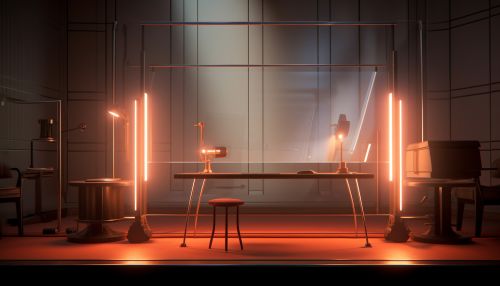Double-slit Experiment
Introduction
The Double-slit experiment is a significant experiment in the field of quantum mechanics. It demonstrates the fundamental concept of wave-particle duality, which posits that all particles can exhibit both wave-like and particle-like properties. The experiment involves shining light through two closely spaced slits in a barrier and observing the resulting pattern on a screen behind the barrier.
Historical Background
The double-slit experiment was first performed by Thomas Young in the early 19th century as a demonstration of the wave theory of light. Young's experiment involved passing a beam of light through two closely spaced slits and observing the resulting interference pattern on a screen. This pattern, consisting of alternating bright and dark bands, was indicative of the wave-like nature of light.
Theoretical Framework
The double-slit experiment is often used to illustrate the principles of quantum mechanics, particularly the concept of wave-particle duality. According to this principle, particles such as electrons and photons can exhibit both wave-like and particle-like properties. This is demonstrated in the double-slit experiment by the creation of an interference pattern when light is shone through the two slits.
The interference pattern is explained by the wave theory of light, which posits that light behaves as a wave, with the peaks and troughs of the wave interfering with each other to create the pattern. When light passes through the two slits, it spreads out and interferes with itself, creating a pattern of bright and dark bands on the screen.
Quantum mechanics provides a further explanation for the results of the double-slit experiment. According to the quantum mechanical interpretation, each photon or electron passes through both slits simultaneously, due to the principle of superposition. This results in a probability distribution that corresponds to the interference pattern observed.
Experimental Setup
The double-slit experiment can be performed using a variety of light sources, including lasers and incandescent bulbs. The light source is directed at a barrier with two closely spaced slits. The light passing through the slits strikes a screen behind the barrier, creating an interference pattern.


The slits in the barrier must be closely spaced and of similar size. The distance between the slits and the screen, as well as the wavelength of the light used, can affect the resulting interference pattern.
Observations and Interpretations
When light is shone through the two slits, an interference pattern of alternating bright and dark bands is observed on the screen. This pattern is consistent with the wave theory of light, as the bright bands correspond to areas of constructive interference (where the peaks of the light waves align), and the dark bands correspond to areas of destructive interference (where the peaks of one wave align with the troughs of another).
The double-slit experiment also provides evidence for the quantum mechanical principle of superposition. According to this principle, each photon or electron passes through both slits simultaneously, creating a probability distribution that corresponds to the interference pattern. This interpretation is supported by the results of variations on the double-slit experiment, in which individual photons or electrons are detected at the screen.
Implications and Applications
The results of the double-slit experiment have profound implications for our understanding of the nature of reality. The experiment demonstrates the fundamental principle of wave-particle duality, suggesting that particles such as electrons and photons do not have definite positions until they are measured.
The double-slit experiment also has practical applications in the field of quantum computing. Quantum computers use the principles of superposition and interference to perform calculations at speeds far exceeding those of classical computers.
